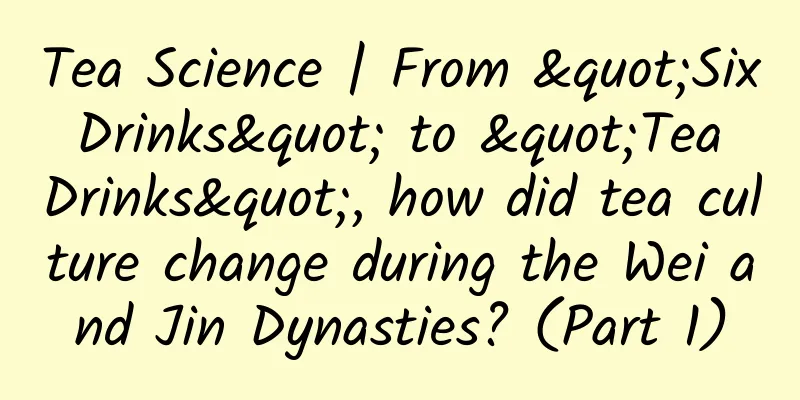Tea Science | From "Six Drinks" to "Tea Drinks", how did tea culture change during the Wei and Jin Dynasties? (Part 1)

|
Lu Yu's "The Classic of Tea - Seven Things" compiled Zhang Mengyang's poem "Climbing Chengdu Tower": "The fragrant tea is the best of the six clear teas, and its flavor spreads to nine regions." Zhang Mengyang is Zhang Zai, who lived around the Taikang period (281-289) of the early Jin Dynasty. His native place was Anping (now Shenzhou City, Hebei Province). His father was the governor of Shu County. At the beginning of the Taikang period, he went to Shu to visit his father in Chengdu and wrote "Climbing the Baitu Tower in Chengdu". The whole poem has 32 lines, but Lu Yu only included 16 lines and shortened it to "Climbing the Chengdu Tower". The "six pures" mentioned in the poem are "six drinks". Pi Rixiu's "Miscellaneous Poems on Tea" and its preface say: "According to the "Book of Zhou", the duty of the wine master is to distinguish the four kinds of drinks, the third of which is "jiang". The duty of the wine man is to provide the king with six drinks: water, jiang, li, jiu, yi, and liu, which are brought to the wine house. Zheng Sinong said: "It is to mix water with wine. At that time, people generally drank wine and li, so the six jiangs are the fermentation of wine." That is to say, before tea was consumed, people generally drank light wine. Although tea was consumed as a drink in the Qin and Han dynasties, and the families of scholars like Wang Bao in the Western Han Dynasty had servants who "made tea with all the utensils", tea drinkers were still very few. Therefore, Han Hong of the Tang Dynasty wrote "Thanks for Tea" for Tian Shenyu, saying: "The ruler of Wu treated the wise with respect, so he prepared tea, and the ministers of Jin loved guests, so they shared tea." During the Three Kingdoms period, the number of tea drinkers increased. Zhang Yi of the Wei Dynasty in the Three Kingdoms period recorded the simple processing technology of tea leaves and the method of mixing and boiling tea to drink. In Wuxing County, Wucheng Wenshan, there was an imperial tea garden that produced imperial tea. Sun Hao, the last king of Wu, entertained Wei Yan and "secretly gave him tea tea as wine". However, during the Three Kingdoms period, tea was still a pastime for the nobility and was rarely consumed by the people. Therefore, Tang Feiwen's "Tea Records" said: "Tea originated in the Eastern Jin Dynasty and flourished in the present." From the "Six Drinks" to tea drinking, the more than 300 years of the Jin and Northern and Southern Dynasties was a gradual period. The importance of this period in the history of the formation of Chinese tea culture is sufficient to prove from the historical materials and figures listed in Lu Yu's "The Classic of Tea - Seven Things". In this chapter, Lu Yu collected 49 historical materials on tea before the Tang Dynasty and listed 43 people related to tea. Among them, there were 39 historical materials and 33 people from the Jin and Southern and Northern Dynasties. During this period, a group of people emerged who had an important influence on the formation of Chinese tea culture. This issue will first talk about Zhang Zai and Du Yu. Zhang Zai Zhang Zai was the spokesperson for tea in the Western Jin Dynasty. He praised Chengdu's tea and chanted "fragrant tea is the best among the six clear flavors, and its flavor spreads to nine regions." He warned people that drinking tea is better than drinking alcohol, and he firmly believed that the fragrance of tea would spread to the whole of China, which was a thought-provoking move. "Climbing Chengdu Tower" also created a precedent for incorporating tea into poetry. Thus, tea and poetry have become inseparable. Other poems that mentioned tea during this period include Zuo Si's "Poem of a Charming Girl", which is also one of the earliest poems to mention tea. The poem has 56 sentences in total, and "The Classic of Tea" only quotes 12 of them. The last two lines mention tea in detail: "My heart is filled with the joy of tea, and I boast about it to the cauldron." They are talking about Zuo Si's two lovely daughters, who "galloped around the garden" and "enjoyed the splendor in the wind and rain" and were so anxious to drink tea that they pouted their little lips and blew air into the furnace. Duyu Du Yu's "Tea Ode" has a pioneering value in the history of the formation of tea culture. It is the earliest tea-related literary fu and the first to record the growing environment, planting, picking and tasting of tea in a relatively complete manner: "The sacred mountain is the peak, where rare products are concentrated. There grow tea grass, which fills the valleys and covers the hills. It receives moisture from the fertile soil and receives sweet spirits from the sky. In the early autumn, farmers have little rest, so they travel together to pick and search for tea." At the same time, "Tea Ode" is also the earliest work discussing the art of tea, and it is the first to describe the wonderful fun of tea soup foam from an aesthetic perspective: "Only when it is first made, the foam sinks and the flowers float, shining like accumulated snow and bright like spring." At the same time, it clearly states that this is derived from: "The water is from Minfang, and it is drawn from the clear stream. The utensils are selected from Tao Jian, which comes from Dongou. It is poured with gourd, and it is taken in the style of Gong Liu." |
<<: Lighthouse inheritance | Ye Shuhua, "Mother of Beijing Time": Every star has its own light
Recommend
Traveling to Jupiter to find water
Opening words How do astronauts live in space? Wh...
A comprehensive plan for Internet marketing and operations, compiled with great effort! !
1. Competitive product analysis 1. Choose competi...
ASUS PadFone mini full review: one device plays two roles
In terms of appearance, the ASUS PadFone mini cont...
What kind of bad consequences will the proliferation of legendary advertisements bring?
Everyone should be familiar with the legendary ga...
WeChat "Search": How to layout keywords to grab traffic
On May 17, WeChat iOS users updated to version 6....
YouTube Marketing Strategy Guide!
Promoting your products in the form of video cont...
Is it because of too many competitors or the Internet that American TV series are not selling well?
John Landgraf's point came like a bolt from t...
Download Douyin Live Streaming Crash Course Baidu Cloud
Download Douyin Live Streaming Crash Course Baidu...
What is the best time to eat breakfast? ——Some simple and nutritious breakfast methods
Author: Xue Qingxin, registered dietitian Reviewe...
A case study of the WeChat Moments distribution that sold 8,000 copies
Event background: On November 13, 2019, I saw a c...
Home gateway applications under the pan-intelligentization of home terminals
Pai Pai Zuo: Home Smart Terminal Since the invent...
Computers are running wild: exponential computing! We still need quantum computing to help
Produced by: Science Popularization China Author:...
Don't give up on the checkup! These "embarrassing" physical examination items can actually detect these serious diseases
Rectal examination, stool examination, breast pal...
No more breaking up! Russia agrees to extend the operation of the International Space Station
Recently, the Russian State Space Corporation ann...
Music Radar: A new opportunity for NetQin's strategic transformation to a platform
Many mobile Internet music lovers may have encoun...









